
AN/PRC 113 Radio Set is a manpack, portable VHF and UHF AM combat radio transceiver manufactured by Magnavox America. [1] In the Joint Electronics Type Designation System (JETDS), AN/PRC translates to "Army/Navy, Portable, Radio, Communication.

AN/PRC 113 Radio Set is a manpack, portable VHF and UHF AM combat radio transceiver manufactured by Magnavox America. [1] In the Joint Electronics Type Designation System (JETDS), AN/PRC translates to "Army/Navy, Portable, Radio, Communication.
The AN/PRC-113 is a tactical, short range, manpack, ground to air / air to ground / ground to ground radio used primarily by Forward Air Controller (FAC) teams, Forward Observers (FO) and Marine Air Command and Control agencies. It was also used by some units in the active army, national guard and reserves, but mostly by support elements. It was first introduced by the Magnavox Corporation in 1986 and was quickly well liked by ground troops because of its simplicity and ease of use. [2]
The AN/PRC 113 consists of the RT-1319 transceiver and minor components. [2] It can provide secure voice communications with the external TSEC/KY-57 device and is compatible with the HAVEQUICK II frequency hopping mode. [1] [2] [3] It is a radio designed to allow ground forces to communicate with aircraft on either the VHF AM aircraft band (116.000 to 149.975 MHz) or the UHF AM aircraft band (225.000 to 399.975 MHz) in 25 kHz steps. [2] [4] Some versions also have FM capabilities that allows communications on the same frequency range in FM mode. Its first use was for the GRC-206 Program Pacer Speak used by Forward Air Controllers (FAC). [4]
All AN/PRC-113s contain a "Guard Receiver" tuned to the military rescue/survival frequency of 243 MHz but not to the civilian counterpart frequency of 121.5 MHz. [4] These radios have been phased out and replaced by the newer manpack ASIP and AN/PRC-148 MBITR radios that cover everything between 2 and 512 MHz. [4]
| Manufacturer Datasheet [5] | |
|---|---|
| Channels: | 8360, including 8 Preset & 1 Guard Channel. |
| Frequency Ranges: | VHF: 116 TO 149.975 MHz; UHF: 225 TO 399.975 MHz |
| Estimated Range: | 5–20 km (3-12 mi) Dependent on conditions. This is the approximate range when not connected to a repeater or a network. |
| Power Output: | 2W to 10W |
| Power Source: | BA-5590/U non-rechargeable or BB-2590/U and UBI-2590 rechargeable batteries. |
| Antenna: | These units use the MPMP100X4 antenna (NSN 5985-01-184-0035). |
| Type of Service: | Line of sight combat Manpack field radio. |
| Weight: | 13.8 lbs w/o batteries, 16.7 lbs w/batteries. |
| Operating temperature: | -29C (-20F) to 68C (154F). |
| MIL-STD: | Exceeds MIL-STD-810G, MIL-STD-461F, MIL-STD-188-141B, MIL-STD-188-181B |
| Note: | A modified version of the AN/PRC-113 is available with FM modulation and is designated the MXF-711-3C. This version has been enhanced to allow a communication using FM in addition to AM modulation. |
Royal Air Force, Royal Australian Air Force, Royal New Zealand Air Force, US Military, US Army Green Berets, US Army Rangers, US Army Night Stalkers, USMC MAGTF, US Navy/USMC VBSS teams, US Navy Seal teams, US Navy/Army/Air Force EOD units, US Air Force TACP and JTAC.

Very high frequency (VHF) is the ITU designation for the range of radio frequency electromagnetic waves from 30 to 300 megahertz (MHz), with corresponding wavelengths of ten meters to one meter. Frequencies immediately below VHF are denoted high frequency (HF), and the next higher frequencies are known as ultra high frequency (UHF).
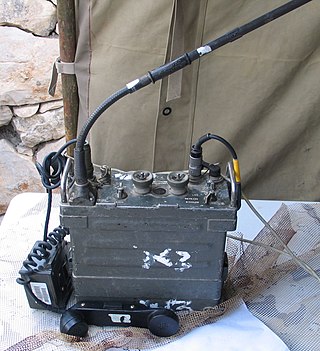
AN/PRC 77 Radio Set is a manpack, portable VHF FM combat-net radio transceiver manufactured by Associated Industries and used to provide short-range, two-way radiotelephone voice communication. In the Joint Electronics Type Designation System (JETDS), AN/PRC translates to "Army/Navy, Portable, Radio, Communication."

A walkie-talkie, more formally known as a handheld transceiver (HT), is a hand-held, portable, two-way radio transceiver. Its development during the Second World War has been variously credited to Donald Hings, radio engineer Alfred J. Gross, Henryk Magnuski and engineering teams at Motorola. First used for infantry, similar designs were created for field artillery and tank units, and after the war, walkie-talkies spread to public safety and eventually commercial and jobsite work.

The Joint Tactical Radio System (JTRS) aimed to replace existing radios in the American military with a single set of software-defined radios that could have new frequencies and modes (“waveforms”) added via upload, instead of requiring multiple radio types in ground vehicles, and using circuit board swaps in order to upgrade. JTRS has seen cost overruns and full program restructurings, along with cancellation of some parts of the program.
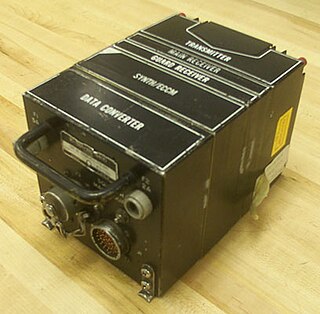
HAVE QUICK is an ECM-resistant frequency-hopping system used to protect military aeronautical mobile (OR) radio traffic.
Bowman is the name of the tactical communications system used by the British Armed Forces.

Clansman is the name of a combat net radio system (CNR) used by the British Army from 1976 to 2010.
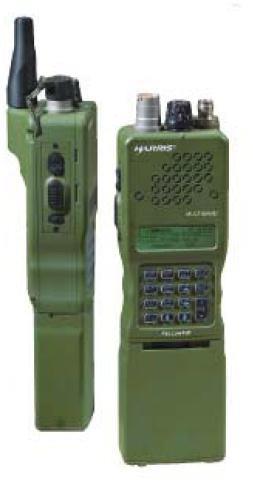
The AN/PRC-152 Multiband Handheld Radio, is a portable, compact, tactical software-defined combat-net radio manufactured by Harris Corporation. It is compliant without waivers to the Joint Tactical Radio System (JTRS) Software Communications Architecture (SCA). It has received NSA certification for the transmission of Top Secret data.

The AN/PRC-150(C) Falcon II Manpack Radio, is a tactical HF-SSB/ VHF-FM manpack radio manufactured by Harris Corporation. It holds an NSA certification for Type 1 encryption. The PRC-150 is the manpack HF radio for the Harris Falcon II family of radios, introduced in the early 2000's.

The AN/PRC-117 translates to "Army/Navy, Portable, Radio, Communication". It is a man-portable, tactical software-defined combat-net radio, manufactured by Harris Corporation, in two different versions:
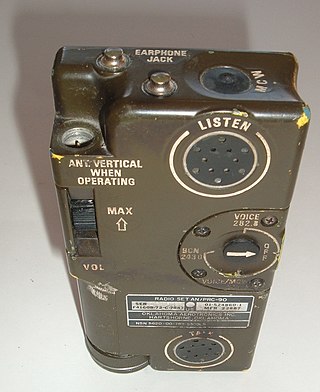
Survival radios are carried by pilots and search and rescue teams to facilitate rescue in an emergency. They are generally designed to transmit on international distress frequencies. Maritime systems have been standardized under the Global Maritime Distress Safety System. Civil and military organisation's utilized different frequencies to communicate and no infringement on either sector would take place. For emergencies involving civilian aircraft, the radio frequency used is VHF 121.5 MHz and for military aircraft incidents, the frequency used is UHF 243 MHz.

The SCR-300 was a portable radio transceiver used by US Signal Corps in World War II. This backpack-mounted unit was the first radio to be nicknamed a "walkie talkie".

The ARC-210 is a family of radios for military aircraft that provides two-way, multi-mode voice and data communications over a 30 to 512+ MHz frequency range. It covers both Ultra High Frequency (UHF) and Very High Frequency (VHF) bands with AM, FM and SATCOM capabilities. The ARC-210 radio also includes embedded anti-jam waveforms, including Havequick and SINCGARS, and other data link and secure communications features, providing total battlefield interoperability and high-performance capabilities in the transfer of data, voice and imagery. It features a separate guard receiver for monitoring 121.5 and 243 MHz while simultaneously monitoring the active channel selected. Transmitter power ranges from 5 to 23 watts, depending on frequency and mode. The radios communicates with other avionics over a MIL-STD-1553 data bus.
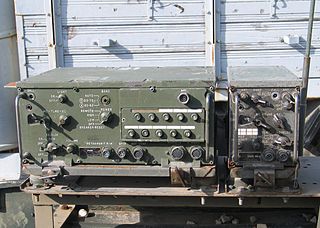
The AN/VRC-12 is the lowest-numbered element of a family of vehicular VHF-FM synthesized vehicular radio communications systems developed by Avco Corporation and introduced around 1963 and used extensively by the U.S. military during the Vietnam War and for many years after. It replaced the earlier AN/GRC-3 through 8 series and was, in turn, replaced by the Single Channel Ground and Airborne Radio System (SINCGARS) in the early 1990s. The sets were manufactured by its original developer, Avco based in Cincinnati, Oh, and Magnavox, Ft. Wayne, Indiana Texas Instruments was one of the principal bidders that proposed improved, ultra-reliable (failure-free) variant of VRC-12 in the late 1960s, but failed to win the competition. RCA bid for ultra-reliable variant in the early 1970s was also unsuccessful.
The AN/ARC-182 is a family of military aircraft radio transceivers designed for two-way, multi-mode voice communications over a 30 to 400 MHz frequency range. It covers both Ultra High Frequency (UHF) and Very High Frequency (VHF) bands with AM, FM, as appropriate. The ARC-182 radio supports the HAVE QUICK II anti-jam waveforms, with an optional control unit. It features a guard channel capability for monitoring 40.5, 121.5, 156.8 and 243 MHz. Transmitter minimum power is 10 watts, AM, and 15 watts, FM. The RT-1250A model radio can communicate with other avionics over a MIL-STD-1553 data bus.
The AN/PRC-10 is an American VHF portable radio transceiver, introduced in 1951 as a replacement for the wartime SCR-300 set. The AN/PRC-8 and AN/PRC-9 sets are basically the same but cover lower frequency bands. It remained in service with the American military until the mid 1960s when it was replaced by the transistorized AN/PRC-25 set.
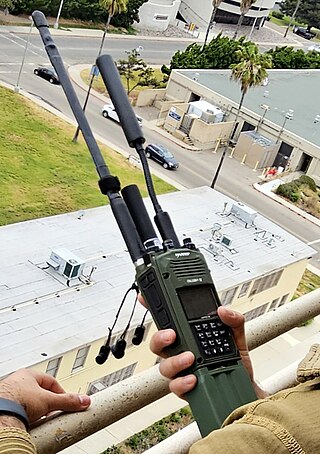
The AN/PRC-163 Multi-channel Handheld Radio, is a dual-channel tactical handheld radio manufactured by L3Harris Technologies, Inc. for the U.S. military, referred to by the U.S. Army as the Leader Radio. It is capable modes such as VHF/UHF Line-of-Sight (VULOS), SINCGARS, Soldier Radio Waveform, Tactical Scalable MANET, P25 as well as the Mobile User Objective System satellite communication mode. The dual channel capability allows a soldier to simultaneously communicate on two separate radio networks. It has received NSA certification for the transmission of Top Secret information with an appropriate encryption key. The PRC-163 is one of the Handheld, Manpack & Small Form Fit (HMS) components of the Integrated Tactical Network family of radios, the U.S. Army's modernization strategy for tactical radios. It is a member of L3Harris' Falcon IV family of tactical radios, and the successor to the Falcon III-family AN/PRC-152 Multiband Handheld Radio.
{{cite web}}: CS1 maint: archived copy as title (link)